Identification of Chemical Constituents in Blumea balsamifera Using UPLC-Q-Orbitrap HRMS and Evaluation of Their Antioxidant Activities
- PMID: 37298979
- PMCID: PMC10254267
- DOI: 10.3390/molecules28114504
Identification of Chemical Constituents in Blumea balsamifera Using UPLC-Q-Orbitrap HRMS and Evaluation of Their Antioxidant Activities
Abstract
Blumea balsamifera (L.) DC., a perennial herb in the Asteraceae family native to China and Southeast Asia, has a notable history of medicinal use due to its pharmacological properties. Using UPLC-Q-Orbitrap HRMS techniques, we systematically investigated the chemical constituents of this plant. A total of 31 constituents were identified, of which 14 were flavonoid compounds. Significantly, 18 of these compounds were identified in B. balsamifera for the first time. Furthermore, the mass spectrometry fragmentation patterns of significant chemical constituents identified in B. balsamifera were analyzed, providing important insights into their structural characteristics. The in vitro antioxidative potential of the methanol extract of B. balsamifera was assessed using DPPH and ABTS free-radical-scavenging assays, total antioxidative capacity, and reducing power. The antioxidative activity exhibited a direct correlation with the mass concentration of the extract, with IC50 values of 105.1 ± 0.503 μg/mL and 12.49 ± 0.341 μg/mL for DPPH and ABTS, respectively. For total antioxidant capacity, the absorbance was 0.454 ± 0.009 at 400 μg/mL. In addition, the reducing power was 1.099 ± 0.03 at 2000 μg/mL. This study affirms that UPLC-Q-Orbitrap HRMS can effectively discern the chemical constituents in B. balsamifera, primarily its flavonoid compounds, and substantiates its antioxidative properties. This underscores its potential utility as a natural antioxidant in the food, pharmaceutical, and cosmetics sectors. This research provides a valuable theoretical basis and reference value for the comprehensive development and utilization of B. balsamifera and expands our understanding of this medicinally valuable plant.
Keywords: Blumea balsamifera; UPLC–Q–Orbitrap HRMS; antioxidant activities; chemical constituents; mass spectrometry fragmentation patterns.
Conflict of interest statement
The authors declare no conflict of interest.
Figures









Similar articles
-
Comparative Analysis of Chemical Composition of Zanthoxylum myriacanthum Branches and Leaves by GC-MS and UPLC-Q-Orbitrap HRMS, and Evaluation of Their Antioxidant Activities.Molecules. 2023 Jul 25;28(15):5631. doi: 10.3390/molecules28155631. Molecules. 2023. PMID: 37570601 Free PMC article.
-
Variations in Essential Oil Yield, Composition, and Antioxidant Activity of Different Plant Organs from Blumea balsamifera (L.) DC. at Different Growth Times.Molecules. 2016 Aug 5;21(8):1024. doi: 10.3390/molecules21081024. Molecules. 2016. PMID: 27527137 Free PMC article.
-
Effects and Mechanisms of Total Flavonoids from Blumea balsamifera (L.) DC. on Skin Wound in Rats.Int J Mol Sci. 2017 Dec 19;18(12):2766. doi: 10.3390/ijms18122766. Int J Mol Sci. 2017. PMID: 29257119 Free PMC article.
-
Phytochemical composition and health properties of Sembung plant (Blumea balsamifera): A review.Vet World. 2021 May;14(5):1185-1196. doi: 10.14202/vetworld.2021.1185-1196. Epub 2021 May 17. Vet World. 2021. PMID: 34220120 Free PMC article. Review.
-
[Research progress on chemical constituents and pharmacological effects of Ajania plants].Zhongguo Zhong Yao Za Zhi. 2023 Jun;48(11):2904-2918. doi: 10.19540/j.cnki.cjcmm.20230125.201. Zhongguo Zhong Yao Za Zhi. 2023. PMID: 37381972 Review. Chinese.
Cited by
-
Mechanism Exploration of Dunyeguanxinning in the Treatment of Atherosclerosis Based on UPLC-Q-Orbitrap HRMS Technology, Network Pharmacology, Molecular Docking and Experimental Validation.J Inflamm Res. 2025 Apr 9;18:4857-4878. doi: 10.2147/JIR.S511604. eCollection 2025. J Inflamm Res. 2025. PMID: 40224390 Free PMC article.
-
Polyphenols of the Inuleae-Inulinae and Their Biological Activities: A Review.Molecules. 2024 Apr 27;29(9):2014. doi: 10.3390/molecules29092014. Molecules. 2024. PMID: 38731504 Free PMC article. Review.
References
-
- Diniz Vilela D., Gomes Peixoto L., Teixeira R.R., Belele Baptista N., Carvalho Caixeta D., De Souza A.V., Machado H.L., Pereira M.N., Sabino–Silva R., Espindola F.S. The Role of Metformin in Controlling Oxidative Stress in Muscle of Diabetic Rats. Oxid. Med. Cell Longev. 2016;2016:6978625. doi: 10.1155/2016/6978625. - DOI - PMC - PubMed
-
- Embuscado M.E. Spices and herbs: Natural sources of antioxidants–a mini review. J. Funct. Foods. 2015;18:811–819. doi: 10.1016/j.jff.2015.03.005. - DOI
-
- Editorial Committee of Flora of China, Chinese Academy of Sciences . Flora of China. 1st ed. Volume 75. Science Press; Beijing, China: 1979. pp. 19–20.
MeSH terms
Substances
Grants and funding
- 20201199/research Fund Project of Guangdong Provincial Administration of Traditional Chinese Medicine
- 202102020630/Guangzhou Basic Research Program Fund Project
- KTP20200175/project supported by Guangdong Rural Science and Technology Commissioner
- 20222ZXKC248/research Project of Online Open Course Steering Committee of Undergraduate Colleges and Universities in Guangdong Province
LinkOut - more resources
Full Text Sources
Medical

